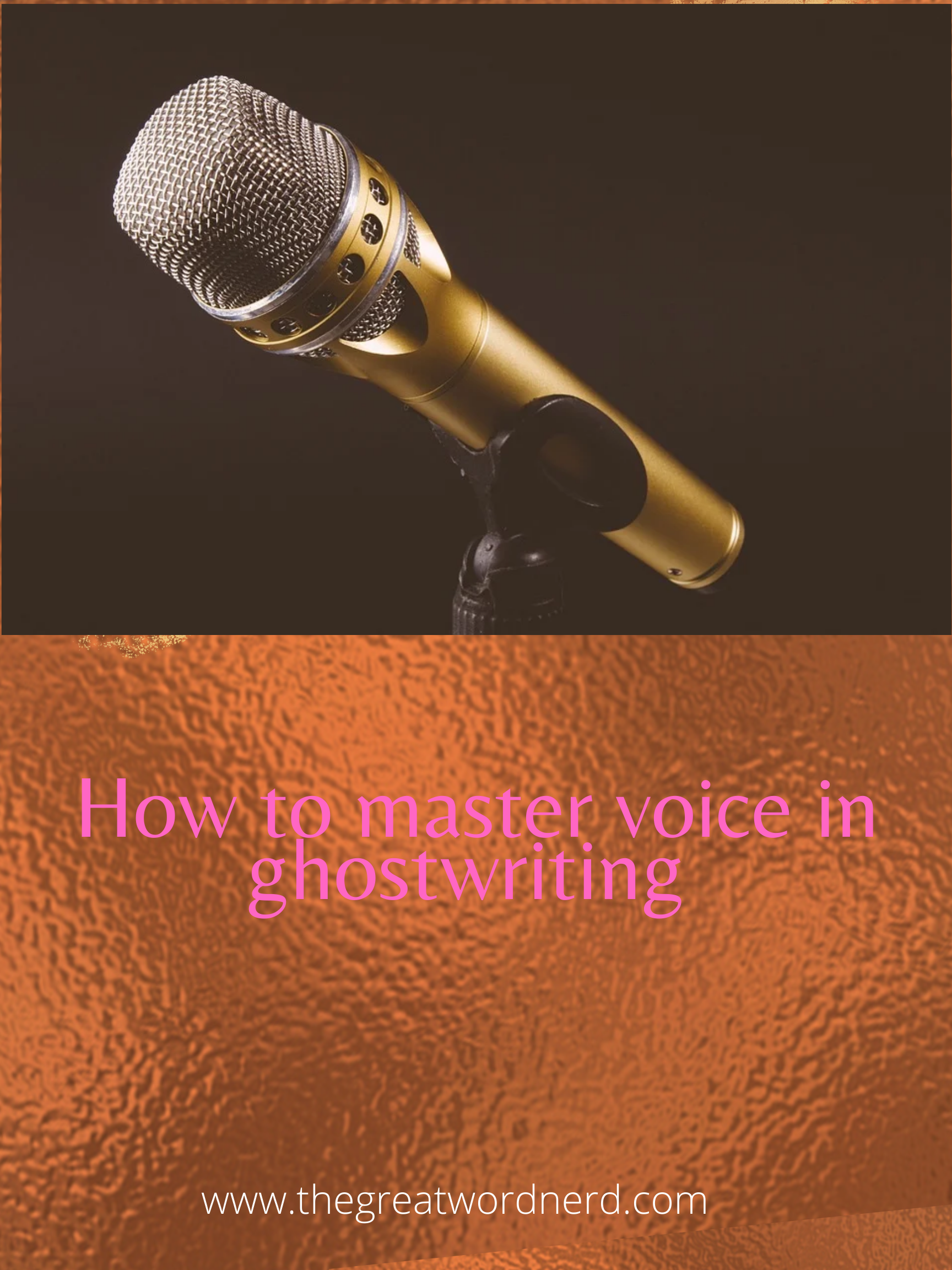Ghostwriting in someone else’s voice is tough.
The only way I can convey it accurately is doing a stroll down memory lane to a time when I was younger. One thing I’d always gotten a kick out of was mimicking people.
There was my friend, who spoke like a sloth, enunciating every word enough to put you to sleep.
There was the aunt who spoke from her nose in a whiny high-pitch tone.
There was the country bumpkin with an accent so heavy you’d expect to see him permanently super glued to cowboy boots and a riding hat.
I even emulated a great Indian accent, shaking my head left to right like a bell (I’d had practice for years growing up around my grandmother). I guess subconsciously, I’ve always been fascinated that every person has a distinct voice unique to just them.
And then I became a writer and voice took on a totally different context.
Voice in life…and writing
The dots started connecting around the time I took on my first ghostwriting assignment. For years, I’d spent time clackering out novels on my keyboard or hammering out blog posts and magazine articles…all without once fretting over conforming to any particular style or voice.
After all, I was writing for me. And that’s the only person I had to sound like.
But the moment I signed on my first ghostwriting project, I knew those days were long over. Now, I’d have to tuck away the voice inside my own head, resist my fingers pulling me to tap out the style in my mind, set aside my personal preferences and adapt to someone else’s idiosyncrasies. It was a challenge. And that’s what excited me.
But it also quickly became a hurdle.
Because even though emulating people vocally is something I knew how to do well, writing like them, I soon realized, was a different beast altogether.
Before we go any further on how I learned to tackle this problem, let’s talk quickly about what voice is and see how it relates to ghostwriting.
What is voice?
As you’ve probably guessed, voice is the distinct way you speak or write. It’s what makes you YOU. It’s your personality shining through your speech and thought patterns. We each have a voice. Yours might be scholarly, lighthearted, inspirational, cynical, etc.
So what makes your voice yours? How is yours different from your neighbor’s or best friend’s? Voice is shaped by your personality, experiences, and outlooks on life.
Take two close friends for example. They could both watch the same movie but describe it in two completely different ways.
One might share a more practical play-by-play description of every scene.
Another might pinpoint the humor and make that the focus of the retelling.
If they were to write their observations, you’d likely see two very different voices (and perhaps styles). One would be more practical and the other humorous. That’s because these individuals have different personalities that shine through in their voices!
Of course, apart from voice, things like style and tone also influence writing, so you’ll need to pay attention to those, too, when you’re ghostwriting.
If you need more clarification around the differences between voice and style and tone, pop on over to this link. Otherwise, you have enough now to move onto the juicy part: how to adapt to someone else’s voice when ghostwriting.
The first step
The whole point of ghostwriting is to write for someone else who may not be as skilled a writer or have the time to do it themselves. They might hire you to craft a blogpost, a book, an article or something else.
But to write like someone else, you first have to know…well, how they write. If possible, ask for a writing sample before you begin any work (even an email they’ve written might work) or tell them to point you to some blog posts that reflect their style, tone, voice, etc.
If they have neither, you’ll need to cross your fingers and base your observations on how they speak. But huge disclaimer here: sometimes the way people speak isn’t the way they write…so beware!
If you’re ghostwriting without a sample, try sharing a few paragraphs or a page of your work to make sure you’ve nailed the voice, etc., your client prefers. This way you won’t be too invested in your draft and have time to course correct, if you need.
Once you have a strong sample of this person’s voice (and style and tone), you’ll need to put on your sleuthing goggles and turn on your thinking caps…because this is where your analyzing work begins!
Although this isn’t a comprehensive list of every nook and cranny you should examine before you begin ghostwriting in someone else’s voice (and style), it’s detailed enough so you can be confident you’re setting foot in the right direction!
Hook
One of the most critical pieces of any writing is crafting the intro. As a writer, we have many different tools at our disposal for kicking off our story. Likely, your client has a preferred style for how they want to start off.
If you’re ghostwriting blogs, pay attention to the hook. Does it jump right into the topic? Or does it ease in by painting a picture or storytelling?
Does the client have specific guidelines on how many words should comprise the intro (ex: 250 words? A specific fraction of the word count)?
Finding out whether your client has a preference will ensure you’re kicking off with a bang and will also help set the tone for the rest of the piece.
Reading level
Some writers like the sound of elaborate, complex sentences. Some whip out shorter, elementary ones. Where your client falls on the spectrum determines their grade level of writing. The Hemingway Editor is a great tool to help you figure out your clients grade level of writing.
Using any writing sample your client shares, you can simply copy and paste in this tool to see how simplistically (or not) you should write. Are their sentences long-winded? Are they short and choppy? Answers to these questions will cue you in.
Knowledge assumption
Some types of writers like dumbing down information; they’ll discuss a topic as though it’s the first time the reader is learning of it. Other writers have a tendency (depending on their audience) to assume knowledge.
For example, you might have one writer who runs a social media blog and talks about tweeting and posting and engagement rates without any explanation about what these terms mean.
On the other hand, another writer who maybe runs a blog for social media beginners may define each term, never assuming that their audience is already familiar with these features. Typically, the preferred style depends more on the audience and less on personal preferences.
Conjunctions to kick off
Every now and again you’ll stumble across someone who’s a stickler for old-school grammar rules, like never starting a sentence with a conjunction. To see if your client fits the bill, check out their writing sample to see whether (and how frequently) they pepper common conjunctions like “and” and “but” at the beginning of sentences.
Contractions
Some of us don’t think twice before slapping an apostrophe on a word while others just don’t dig them. In other words, contractions are a style that some people prefer to do without. So make sure you understand what your client thinks of them. Do you they like saying “I am” or is “I’m” acceptable?
Sarcasm/wit/humor
So far, we’ve discussed many stylistic preferences. But this is where we get into more of the “voice” associated bits of your writing.
Think about your favorite blogger. Chances are you notice their posts pretty much sounds the same, no matter the topic, although their tone may vary.
Formal writers will probably stick to a more dry, direct writing style, steering clear of humor.
Writers who want to inform and entertain or keep the conversation light won’t be opposed to injecting wit or humor every now and again. Maybe they’ll sprinkle in a pun, whip out a riddle or squeeze in a joke. Analyze which of these two approaches define your client.
Diction
Have you ever spoken to someone who spoke so buttoned up, they might as well have been wearing a business suit, pitching to executives?
On the contrary, ever met someone who had the vocabulary of a kindergartner (but wasn’t one)?
I live in Georgia and have people type out words like “ya’ll” all the time.
Some people just have a natural inclination to use big, fancy words. Others prefer simpler terms. Others, still, may adapt to the surrounding dialect.
Words establish voice in a big way.
For example, does your client say “we must collaborate” or “let’s work as a team”?
If your client uses legalese language, like “shall” and “hence” instead of “should” or “that means,” it also adds stiffness to their voice, making them sound more scholarly.
On the other hand, using contractions makes for a less formal conversation. Think about how a slight change from using “can’t” versus “cannot” in a sentence can change the way it sounds.
These are distinct choices that make your client’s voice theirs.
Directness
Some writing styles are crisp and blunt, using strong, impactful words and chopping everything else. Others tend to ramble, much like a natural conversation might, making several turns and taking a few detours before getting to the point. Which style describes your client’s?
Sentence cadence/rhythm
Rhythm is the seductive beat your sentences dance to. It’s what the reader hears in their head when they’re reading what you wrote. Some writers are extremely seductive while others are on the cusp of sounding robotic, barely able to make their sentences sway.
Notice the difference between these two examples:
Example 1: I went to the store. It was closed. I will go back tomorrow. I’m not looking forward to it.
Example 2: I went to the store, but it was closed. Bummer. I guess I’ll have to go back tomorrow, which I’m not looking forward to!
Notice the lilts you hear with the second example, whereas the first one sounds like it’s coming from a robot?
Does your client have sentences that vary and sound rhythmic? Or do they dance to a more muted beat, closer to sounding like the first example?
Jargon
Depending on the audience, your client may use lots of jargon in their writing (think an IT or technically savvy audience) in which case you’d better get on board with their lingo! Or they may discourage jargon at all.
Again, whether jargon is used might depends more on the audience’s knowledge and less on your client’s personal preferences. But it’s still an important point to know before you write so you can get up to snuff with common lingo.
Active/passive construction
Any writer worth his salt knows that passive voice is a big no-no. But some types of writing, like corporate talk, often use this style. It’s also common to use passive voice when you’re trying to be vague or avoid mentioning the person who is doing the action.
Active: I hit the cat.
Passive: The cat was hit.
You can see why the person hitting this poor cat might opt for the passive voice versus fessing up that they’re the actual culprit behind the abuse!
Other things to keep an eye out for
We’ve shared a pretty exhaustive list today. This brings us to the tail of it. But a few more things you might note as you’re putting your analytical caps on:
- Are similes and metaphors part of the writer’s natural style?
- Is the writer okay with using sentence fragments or are they a stickler for complete, proper sentences?
- Are transitions natural or are they more blatant, signaled by words like “first,” “therefore,” “additionally”, etc.?
It’s all in the details
Finally, remember that the point of ghost writing is to mimic the style of your client so you sound like them in writing–not to be the grammar and style police!
You might not always agree with their take on several of these topics. Maybe their preferences are even grammatically incorrect. But as a ghostwriter, your job is to write like them, not fix their writing!
Here’s a quick summary of what you should have learned today. Before starting on any ghostwriting project, you should:
- Get a writing sample from the client. If you can’t, pay attention to or record the way they talk to get a flavor of their voice and style before ghostwriting.
- Start analyzing their speech/writing patterns and preferences.
- Remember that people’s written and oral voice and style can be different–even though they come from the same person!
Till next time, happy writing!
Cheers-
Salina


